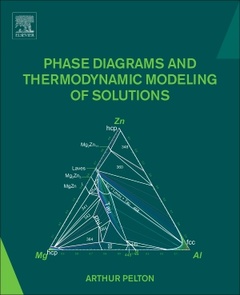Phase Diagrams and Thermodynamic Modeling of Solutions
Auteur : Pelton Arthur D.

Phase Diagrams and Thermodynamic Modeling of Solutions provides readers with an understanding of thermodynamics and phase equilibria that is required to make full and efficient use of these tools. The book systematically discusses phase diagrams of all types, the thermodynamics behind them, their calculations from thermodynamic databases, and the structural models of solutions used in the development of these databases. Featuring examples from a wide range of systems including metals, salts, ceramics, refractories, and concentrated aqueous solutions, Phase Diagrams and Thermodynamic Modeling of Solutions is a vital resource for researchers and developers in materials science, metallurgy, combustion and energy, corrosion engineering, environmental engineering, geology, glass technology, nuclear engineering, and other fields of inorganic chemical and materials science and engineering. Additionally, experts involved in developing thermodynamic databases will find a comprehensive reference text of current solution models.
Part I Thermodynamics and Phase Diagrams1. Introduction2. Thermodynamic fundamentals3. Gibbs Phase Rule4. Fundamentals of the thermodynamics of solutions5. Binary T-composition phase diagrams6. Ternary T-composition phase diagrams7. General phase diagram sections8. Equilibrium and non-equilibrium cooling9. Aqueous and concentrated aqueous systems10. Phase diagrams involving second-order and higher-order transitions
Part II – Thermodynamic Modeling of Solutions11. Introduction12. Single-sublattice random-mixing (Bragg- Williams (BW)) models13. Single-sublattice models with short-range-ordering (SRO)14. Two-sublattice models – Molten salts15. Multiple sublattice models – The Compound Energy Formalism (CEF)16. The Modified Quasichemical Model in the quadruplet approximation17. Order-disorder transitions18. Applications of models to various classes of solutions
Exercises
The book is primarily directed towards students and professionals doing research and development in materials science, metallurgy, combustion and energy, corrosion engineering, environmental engineering, geology, glass technology, nuclear engineering and other fields of inorganic chemical and materials science and engineering.
Dr. Pelton received his undergraduate and graduate degrees from the Dep’t. of Metallurgy and Materials Science at the University of Toronto (PhD in 1970). Following post-doctoral studies at the Technical University in Clausthal, Germany and at MIT, he joined the faculty of the Ecole Polytechnique in the Dep’t. of Materials Engineering in 1973. Dr. Pelton has co-authored over 250 technical papers and 16 book chapters, including the chapter on Phase Diagrams in “Physical Metallurgy 3rd and 4th editions (Elsevier), and on Thermodynamics and Phase Diagrams in the 5th edition. He is a Fellow of the Royal Society of Canada, the Canadian Academy of Engineering and the American Society for Materials. He is a recipient of the AIME Extraction & Processing Distinguished Lecturer Award, the Gibbs Triangle Award of the international Calphad (Calculation of Phase Diagrams) group, the J. Willard Gibbs Phase Equilibria Award of ASM and the Hume-Rothery Prize (for contributions to the study of phase equilibria) of the Institute of Materials (UK) as well as other national and international awards. His primary field of interest is chemical thermodynamics. He is co-founder of the FactSage thermodynamic database computing system which has approximately 900 users in 45 countries.
- Presents a rigorous and complete development of thermodynamics for readers who already have a basic understanding of chemical thermodynamics
- Provides an in-depth understanding of phase equilibria
- Includes information that can be used as a text for graduate courses on thermodynamics and phase diagrams, or on solution modeling
- Covers several types of phase diagrams (paraequilibrium, solidus projections, first-melting projections, Scheil diagrams, enthalpy diagrams), and more
Date de parution : 09-2018
Ouvrage de 401 p.
19x23.3 cm



